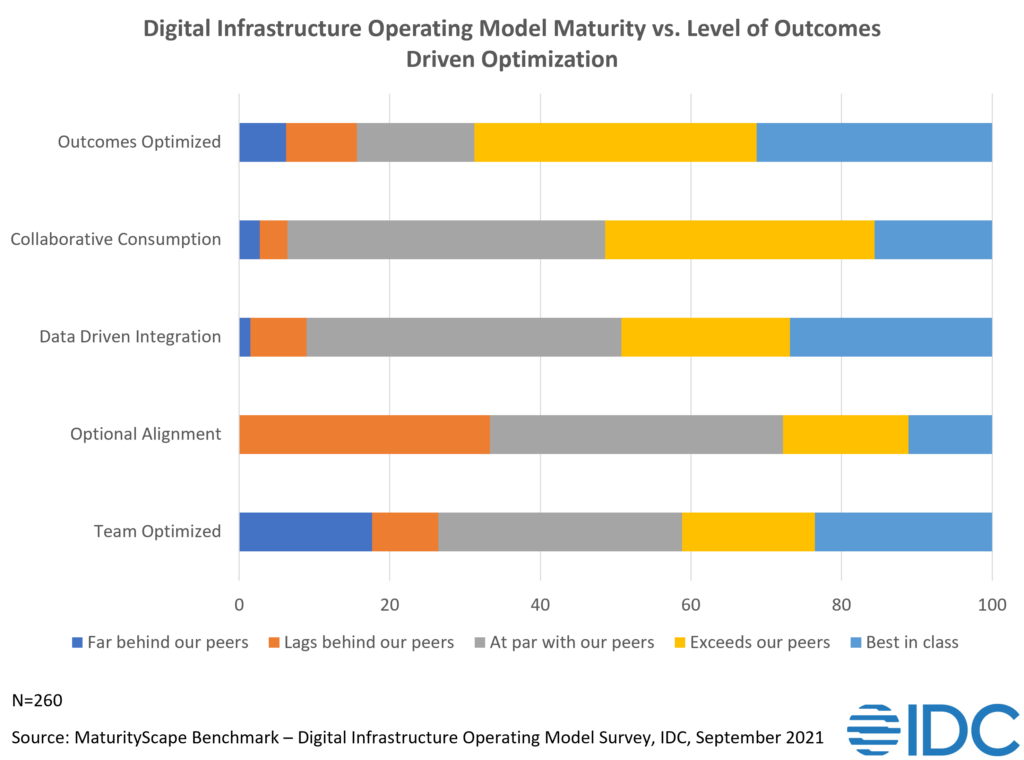Digital business depends on the resiliency, security and scalability of the digital infrastructure that supports mission critical workflows, data analytics and business process automations. Digital infrastructure management and security staff need to be able to apply consistent policies across public cloud, edge and dedicated on premises platforms, while ensuring application availability and performance meets, or exceeds, customer and employee expectations. In many cases, this requires a shift towards more autonomous operations approaches and consumption-based sourcing models, that allow IT, DevOps and LOB teams to focus more closely on business outcomes.
Simultaneously, organizations often shift significant infrastructure configuration, integration, and lifecycle refresh responsibilities to vendors and service providers as part of as-a-service agreements. Relationships with traditional channel and system integration partners also evolve as value becomes concentrated in application and automation-related skills, rather than more traditional feeds and speeds expertise.
For many organizations, this pivot can be disruptive, or even threatening, to many internal operations staff and teams. Finance organizations may find new funding models less predictable and struggle with a transition from OpEx to CapEx budgeting. Development teams may resist adoption of security and compliance guardrails, for fear they will slow innovation.
IDC’s research shows organizations that are most effective in implementing innovative digital infrastructure architectural, operations and financing models often define clear visions focused on business outcomes. These organizations track and report business-aligned Key Performance Indicators (KPIs) and Objective and Key Results (OKR) to incent changes and document benefits.
Defining and tracking meaningful KPIs and OKRs for digital infrastructure requires leadership teams to look beyond traditional IT metrics, such as availability, uptime, ratios of admins to servers, or server utilization. In a recent MIT Sloan Management Review article, Digital Business Needs New KPIs, Here’s Why They Matter, author Brian Eastwood discussed how leading digital business innovators, such as Slack and Adidas America, are using KPIs to inspire, not just inform their organization.
These organizations focus on a few, high impact KPIs to “provide all employees with a specific focus for their work and an understanding of what matters most.” IDC’s recently published IDC MaturityScape: Digital Infrastructure Operating Model 1.0 (IDC #US47596521, August 2021) describes a number of dimensions that collectively help organizations implement mature, business-aligned approaches to the design, control and consumption of their digital infrastructure resources.
A recent benchmark survey designed to measure the level of maturity across enterprises in the U.S. shows that most (62.1%) are still in the ad hoc or opportunistic stages of developing digital infrastructure governance strategies, led by KPIs that are collaboratively developed across business, development, and IT teams.
When considering overall operating model maturity, 68.8% of decision makers who describe their approach as ‘outcomes optimized’ rate their overall level of maturity as exceeding their peers or best in class, compared to just 41.1% of those that rely on team specific metrics (see Figure). The majority, 59.4% of organizations that use outcomes-based governance reported they rely on a highly collaborative approach to governance, while just 26.5% of organizations using teams-focused metrics have a collaborative, cross-functional approach to governance.

When working to align digital infrastructure goals and investments with top line corporate KPIs, the onus is on each team to examine its process models, metrics and reporting approaches, to determine how to create a small number of compelling measures to track and report across the team.
KPIs are typically used to monitor high impact metrics over time, while OKRs may change as strategic projects are completed. Together, KPIs and OKRs can help digital infrastructure leadership teams improve employees’ understanding of the benefits of transforming operations, financing, and architectural strategies.
For many organizations, the starting point in this effort needs to focus on understanding business priorities. IDC’s research shows that the majority of outcome optimized organizations focus on topline business outcomes related to:
- Customer satisfaction
- Employee productivity
- Operational efficiency
After identifying the top priority business outcomes and overall business KPIs, each team needs to consider what choices and activities within their organizations have the most impact on these KPIs. For digital infrastructure, that ability for developers to implement security and configuration as code, using reusable, standardized templates and tools, might have a major impact.
KPIs focused on percentage of infrastructure configuration and security controlled by programmatic automation might help drive alignment around that goal. OKRs tied to building out the most impacting automation portfolio and training staff might provide more granular and immediate focus.
For other organizations, however, the focus might need to be targeted at the way the data collected from sensors, edge platforms, and end user experience reporting are integrated and analyzed, to improve the accuracy and performance of critical monitoring and alerting systems for product safety. KPIs related to speed of data access, normalization, and reporting may be most impactful with OKRs that prioritize migration to cloud-based storage and analytics.
In many cases, it may still be helpful to continue to track and report on existing team and technology level metrics. In many cases these traditional metrics can contribute insight to higher level KPIs. More importantly, however, decision makers need to ensure that they are able to collect and interpret data that is relevant to the most critical KPIs.
They need to think about dependencies and barriers to achieving the top line business KPIs and how to best manage their organizations contribution to achieving the overall goals. Progress toward top line business KPIs should be communicated across the organization, to senior level decision makers and to employees to help ensure ongoing alignment.
As OKRs are achieved, they will need to be updated. KPIs will also need periodic refreshes in alignment with ongoing business strategy updates. As business becomes more digital, data about end user experience, transaction health, end to end performance, and digital infrastructure performance bottlenecks and dependencies will be increasingly available. Sorting through the noise to identify, track, and report the most impactful signals will be a vital skill, for digital infrastructure leadership teams.
Interested in learning more about autonomous operations? Download IDC’s checklist, Best Practices: Autonomous Operations for Digital Infrastructure.




